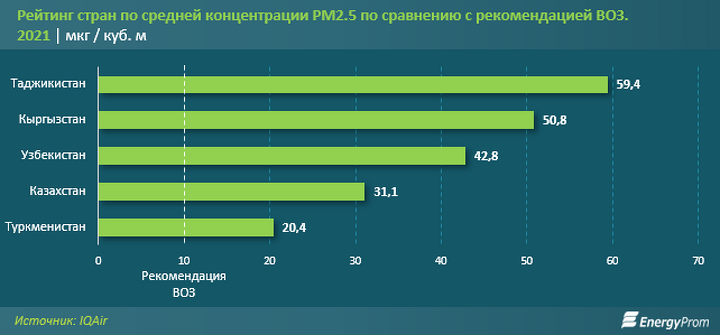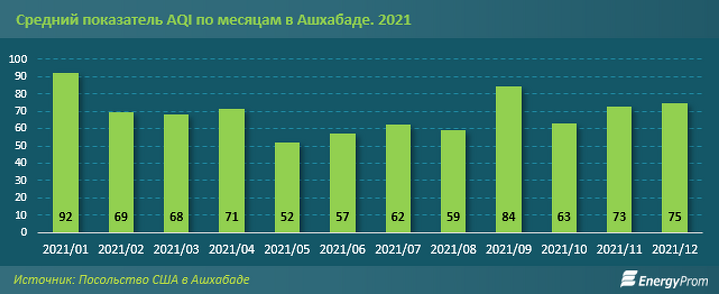Smog not only affects citizens’ health, it also causes economic damage through premature death, illness, and lost productivity. In 2019, air pollution cost Kazakhstan’s economy $10.5 billion. Worse, the problem is spreading across Central Asia, where none of the five countries have air that meets WHO safety standards.
Air quality is affected by the content of fine particles PM2.5, this air pollutant is a product of combustion of substances, it is contained in car exhaust gases, is emitted during the burning of wood and coal, and also during forest fires.
WHO recommends that the concentration of these particles in the air should not exceed an average of 10 micrograms per cubic meter. However, air pollution in Central Asian countries significantly exceeds this limit.

In 2021, Tajikistan ranked first in Central Asia for air pollution and fourth in the world, according to IQAir , a global air quality monitoring platform. That same year, Kyrgyzstan, Uzbekistan, and Kazakhstan exceeded WHO standards by five, four, and three times, respectively. The least polluted air was in Turkmenistan, where annual particle concentrations were twice the norm.
There are at least 24 coal-fired power plants in Tajikistan’s capital, Dushanbe, Cabar.Asia reports . Coal is also used by more than 400 other industrial plants, which fill the gray, muggy “cloud” over the city. The constant smog makes the city look washed out. The cement plant, which regularly dumps dust on the capital, also contributes to this drabness.
In all of 2021, there was not a single day in Dushanbe with “good” air according to the AQI scale (data is missing for two days: May 22 and 23). At the same time, there were four days during the year when the air was “hazardous” for health. During such times, everyone should avoid any outdoor activities, the US Environmental Protection Agency recommends .

Almost a quarter of all days in 2021, the air in Dushanbe was “satisfactory” and only dangerous for people sensitive to polluted air. However, the rest of the time — that is, three out of four days a year — the air was bad, with pollution levels ranging from “unhealthy for sensitive groups” to “hazardous.”
The remaining Central Asian countries were ranked in the 2021 global ranking as follows:
• Kyrgyzstan — 7th place;
• Uzbekistan — 12th place;
• Kazakhstan — 23rd place;
• Turkmenistan — 44th place.
All countries, however, worsened their performance compared to 2020.
Although air quality is a year-round problem, it becomes more acute in the fall and winter, when cities are engulfed in smog from coal-fired heating systems and vehicle exhaust.
The difference is most obvious in Almaty and Bishkek. In winter, these cities share the highest AQI value in the region at 142. As the weather warms, there is a break, and in November, the smog returns with a rating of “unhealthy for sensitive groups.”
Almaty and Bishkek also have the biggest difference in air pollution in winter compared to summer months, with air four and three times cleaner and better, respectively. During the warm period of 2021, the air was on average “good” — the AQI did not exceed 50.

In Tashkent (Uzbekistan) and Dushanbe (Tajikistan), the concentration differed from the Kyrgyz and Kazakh dynamics. Here, the air was bad almost all year round, and in winter it became worse only by 17% and 9% compared to summer. This is due to additional sources of pollution, such as dust storms, industrial plants or waste incineration plants, which produce pollutants regardless of the time of year.
In Tashkent, the only exceptions were three months, April, May and June, when the air was satisfactory with the following AQI values: 93, 81 and 92 respectively. In Dushanbe, these were March and April with indices of 100 and 86 respectively. But it is enough for these indices to rise to 101, and the air already becomes “unhealthy for sensitive groups”.
When looking at the average AQI value over the year, Tashkent and Dushanbe were the only two of the five capitals where the air was “unhealthy for sensitive groups.” This means that active children and adults, as well as people with respiratory diseases, should limit their time spent outdoors for long periods at all times.

As for Turkmenistan’s capital Ashgabat, it had the lowest AQI readings of the five countries, with an annual average of 69. This is considered “satisfactory” on the AQI scale.

